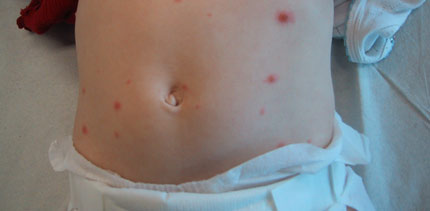Chickenpox
Varicella (Latin name)By Bjarne Lühr Hansen PhD, MD and Philipp Skafte-Holm MD, Mentor Institute
Chickenpox is a highly contagious childhood disease you only have once in a lifetime. Chickenpox appears as fever and a rash consisting of spots, blisters and crusts covering the entire body. If your child seems drowsy or have trouble breathing you must contact a doctor immediately.
Chickenpox is a highly contagious disease caused by a virus.
You only have chickenpox once in a lifetime.
Most people have the disease when they are in kindergarten or in school.
Chickenpox begins with a light fever and a headache for 1 to 2 days followed by the rash. The rash starts in the face and on the chest. Later it spreads to the scalp, arms and legs. The rash can also affect the mucous membranes in the mouth. The temperature will rise to approximately 39-40ºC.
The rash develops from itchy red spots to larger buds that turn into blisters – the blisters look like drops of water surrounded by a red circle. In the course of a few days the blisters dry up or bursts and are transformed into crust. The child will typically have all different types of chickenpox – at the same time. The number of chickenpox can vary from many hundreds to quite few.

The illness usually lasts one week.
It varies a lot how battered the children can become. The youngest children usually surmount the illness quite lightly while older children get the worst of it – they can have many chickenpox and high fever.
Since the rash is itchy, the child wants to scratch the chickenpox. This can be unfortunate since it can lead to inflammation with bacteria in the skin around the chickenpox. Inflammation in the skin around the chickenpox can be detected by the skin becoming increasingly red and swollen. Possibly thickly goo leaks from the chickenpox.
